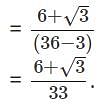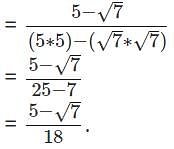Class 9 Exam > Class 9 Tests > Mathematics (Maths) Class 9 > Test: Real Numbers - Class 9 MCQ
Test: Real Numbers - Class 9 MCQ
Test Description
20 Questions MCQ Test Mathematics (Maths) Class 9 - Test: Real Numbers
Test: Real Numbers for Class 9 2024 is part of Mathematics (Maths) Class 9 preparation. The Test: Real Numbers questions and answers have been
prepared according to the Class 9 exam syllabus.The Test: Real Numbers MCQs are made for Class 9 2024 Exam. Find important
definitions, questions, notes, meanings, examples, exercises, MCQs and online tests for Test: Real Numbers below.
Solutions of Test: Real Numbers questions in English are available as part of our Mathematics (Maths) Class 9 for Class 9 & Test: Real Numbers solutions in
Hindi for Mathematics (Maths) Class 9 course. Download more important topics, notes, lectures and mock
test series for Class 9 Exam by signing up for free. Attempt Test: Real Numbers | 20 questions in 20 minutes | Mock test for Class 9 preparation | Free important questions MCQ to study Mathematics (Maths) Class 9 for Class 9 Exam | Download free PDF with solutions
Detailed Solution for Test: Real Numbers - Question 1
Detailed Solution for Test: Real Numbers - Question 2
| 1 Crore+ students have signed up on EduRev. Have you? Download the App |
Detailed Solution for Test: Real Numbers - Question 3
Detailed Solution for Test: Real Numbers - Question 4
Detailed Solution for Test: Real Numbers - Question 5
Detailed Solution for Test: Real Numbers - Question 6
Detailed Solution for Test: Real Numbers - Question 7
Detailed Solution for Test: Real Numbers - Question 8
Detailed Solution for Test: Real Numbers - Question 9
Detailed Solution for Test: Real Numbers - Question 10
Detailed Solution for Test: Real Numbers - Question 11
Detailed Solution for Test: Real Numbers - Question 12
Detailed Solution for Test: Real Numbers - Question 13
Detailed Solution for Test: Real Numbers - Question 14
Detailed Solution for Test: Real Numbers - Question 15
Test: Real Numbers - Question 16
The largest number which divides 70 and 125, leaving remainders 5 and 8 respectively, is
Detailed Solution for Test: Real Numbers - Question 16
Detailed Solution for Test: Real Numbers - Question 17
Detailed Solution for Test: Real Numbers - Question 18
Detailed Solution for Test: Real Numbers - Question 19
Detailed Solution for Test: Real Numbers - Question 20
|
44 videos|412 docs|55 tests
|
Information about Test: Real Numbers Page
In this test you can find the Exam questions for Test: Real Numbers solved & explained in the simplest way possible.
Besides giving Questions and answers for Test: Real Numbers, EduRev gives you an ample number of Online tests for practice
|
44 videos|412 docs|55 tests
|
Download as PDF


 we get __________
we get __________

 we get __________
we get __________ we will get same expression since
we will get same expression since 

 we get __________
we get __________



 we get __________
we get __________ we will get same expression since
we will get same expression since 


 we get __________
we get __________ we will get same expression since
we will get same expression since 





















